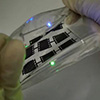| May 13, 2024 |
|
(Nanowerk News) A joint research team, led by Dr. Chanwoo Yang and Researcher Seong Ju Park from Korea Institute of Industrial Technology (KITECH), along with Prof. Jin Kon Kim and Dr. Keon-Woo Kim from POSTECH, has successfully developed a compact energy storage device with excellent elasticity.
|
|
This research was published in npj Flexible Electronics (“Deformable micro-supercapacitor fabricated via laser ablation patterning of graphene/liquid metal”).
|
 |
| The highly deformable micro supercapacitor. (Image: KITECH)
|
|
Beyond foldable and rollable devices, the era of stretchable IT devices is arriving. For these devices, the development of small, elastic energy storage devices is essential. In this respect, micro supercapacitors (MSCs) are gaining attention as very small volumes that can power such electronic devices. However, the solid metals commonly used as current collectors, such as gold (Au), have inherently limited stretchability, significantly restricting their potential for deformation.
|
|
In this study, the team selected gallium-indium liquid metal (EGaIn) as the MSC current collector. EGaIn has very high conductivity and, due to its liquid nature, is easily deformable. However, shaping it has posed significant technical challenges. To overcome this, the team devised a method of patterning EGaIn using a laser. They successfully used the intense energy of the laser to pattern EGaIn simply and precisely, applying it effectively as the MSC’s current collector.
|
|
Based on this technology, the research team was able to create an MSC that could be stretched and shrunk over 1,000 times without any loss of energy storage performance. Furthermore, this device demonstrated stable energy supply capability even when twisted, folded, or crumpled.
|
|
Dr. Yang stated, “Laser technology allows for precise work while also speeding up the process,” and expressed his hope that “this research will be useful in various industrial fields and contribute to the development and commercialization of elastic energy storage devices.”
|


